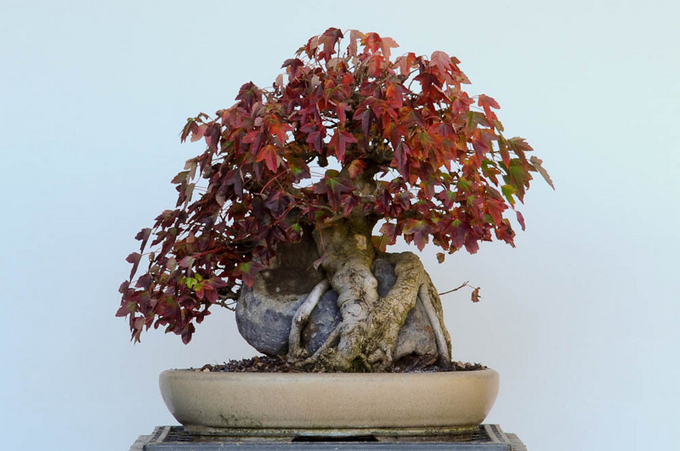 This Trident maple root-over-rock belongs to Jonas Dupuich. It’s from a Bonsai Tonight article about the 11th Bay Island Bonsai Exhibit. The Bay Island Bonsai 13th Annual Bonsai Exhibit is coming very soon (Jan
This Trident maple root-over-rock belongs to Jonas Dupuich. It’s from a Bonsai Tonight article about the 11th Bay Island Bonsai Exhibit. The Bay Island Bonsai 13th Annual Bonsai Exhibit is coming very soon (Jan 13-14 14-15). Judging by photos from previous exhibits, it looks like it’s one of the better bonsai shows in North America. It’s at the Oakland Lakeside Garden Center, 666 Bellevue Ave. For more information: (510) 919-5042 or visit their website.
 The following turned out to be much ado about almost nothing (12/24/12). Bad news about lime sulfur. It’s hard to imagine bonsai without lime sulfur. But it looks like that’s exactly what we’ll have to do. At least those of us who live in States. Rather than trying to explain what’s happened, I’ll leave it to the expert, Colin Lewis, our favorite lime sulfur source (and author of Bonsai Survival Manual, among other things): “To get straight to the point: Lime sulfur is now totally banned in 46 states. Of the remaining four states, two only permit the use of lime sulfur under special license and the other two are currently processing a total ban….” (scroll down for the whole story).
The following turned out to be much ado about almost nothing (12/24/12). Bad news about lime sulfur. It’s hard to imagine bonsai without lime sulfur. But it looks like that’s exactly what we’ll have to do. At least those of us who live in States. Rather than trying to explain what’s happened, I’ll leave it to the expert, Colin Lewis, our favorite lime sulfur source (and author of Bonsai Survival Manual, among other things): “To get straight to the point: Lime sulfur is now totally banned in 46 states. Of the remaining four states, two only permit the use of lime sulfur under special license and the other two are currently processing a total ban….” (scroll down for the whole story).
 I’ve always had a soft spot for Columbus, Ohio. I won’t bore you with my reasons, but I will suggest that you visit the Columbus Bonsai Society’s excellent website, and if you ever find yourself anywhere in the vicinity, why not get in touch? However, I must admit that I was just slightly miffed to see that they didn’t feature any Stone Lantern books in their quite extensive book review section. I still recommend that you check their book reviews out, but I might also most humbly recommend that they expand their reviews to include some of these: Masters’ Series Pine Book, Masters’ Series Juniper Book, The Magician, Kimura 2, Shohin Bonsai, Bonsai from the Wild, Satsuki Azaleas & Bonsai Today Pocket Gallery.
I’ve always had a soft spot for Columbus, Ohio. I won’t bore you with my reasons, but I will suggest that you visit the Columbus Bonsai Society’s excellent website, and if you ever find yourself anywhere in the vicinity, why not get in touch? However, I must admit that I was just slightly miffed to see that they didn’t feature any Stone Lantern books in their quite extensive book review section. I still recommend that you check their book reviews out, but I might also most humbly recommend that they expand their reviews to include some of these: Masters’ Series Pine Book, Masters’ Series Juniper Book, The Magician, Kimura 2, Shohin Bonsai, Bonsai from the Wild, Satsuki Azaleas & Bonsai Today Pocket Gallery.
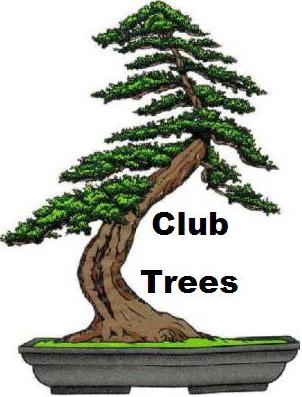
 Congrats! The Phoenix Bonsai Society is celebrating their 50th birthday. That’s impressive. What’s even more impressive is their website. It’s one of the most informative bonsai sites anywhere, and I’m not just saying that because they gave me a $100 kickback (just kidding, it really is a uniquely rich source for valuable bonsai information). Check it out for yourself.
Congrats! The Phoenix Bonsai Society is celebrating their 50th birthday. That’s impressive. What’s even more impressive is their website. It’s one of the most informative bonsai sites anywhere, and I’m not just saying that because they gave me a $100 kickback (just kidding, it really is a uniquely rich source for valuable bonsai information). Check it out for yourself.
 Tyler Sherrod, bonsai apprentice. I don’t know if I’ve already recommend you visit Tyler’s blog, but just in case I haven’t…
Tyler Sherrod, bonsai apprentice. I don’t know if I’ve already recommend you visit Tyler’s blog, but just in case I haven’t…
 Wire versus Wire. We’ve been fielding lots of questions lately about the difference between our Bonsai Aesthetics Wire and our Japanese wire. Basically, the Japanese wire is a little stiffer and therefor a little stronger. Which means the Bonsai Aesthetics wire is a little softer and therefor a little easier to apply. Because the Aesthetics wire is so affordable and the difference in holding power isn’t that great, I believe that the Bonsai Aesthetics wire is a better deal. This takes nothing away from the Japanese wire, which, given our large discounts, is also a very good deal.
Wire versus Wire. We’ve been fielding lots of questions lately about the difference between our Bonsai Aesthetics Wire and our Japanese wire. Basically, the Japanese wire is a little stiffer and therefor a little stronger. Which means the Bonsai Aesthetics wire is a little softer and therefor a little easier to apply. Because the Aesthetics wire is so affordable and the difference in holding power isn’t that great, I believe that the Bonsai Aesthetics wire is a better deal. This takes nothing away from the Japanese wire, which, given our large discounts, is also a very good deal.
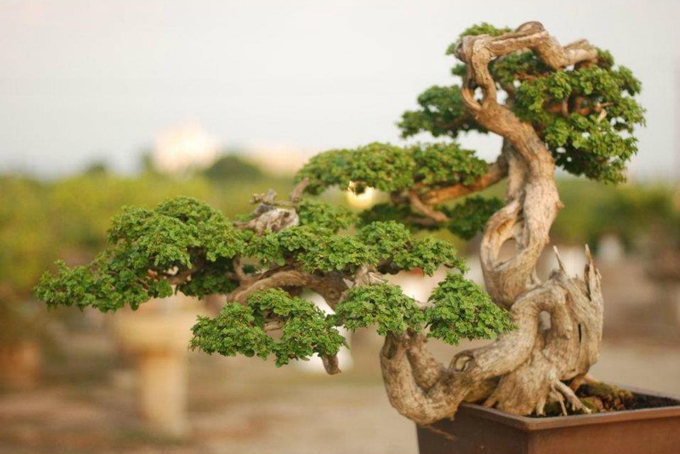 An eccentric and compelling bonsai. There’s so much going here, that I won’t bother to say anything. Except that it’s a Premna and it’s from Taiwan Bonsai World.
An eccentric and compelling bonsai. There’s so much going here, that I won’t bother to say anything. Except that it’s a Premna and it’s from Taiwan Bonsai World.
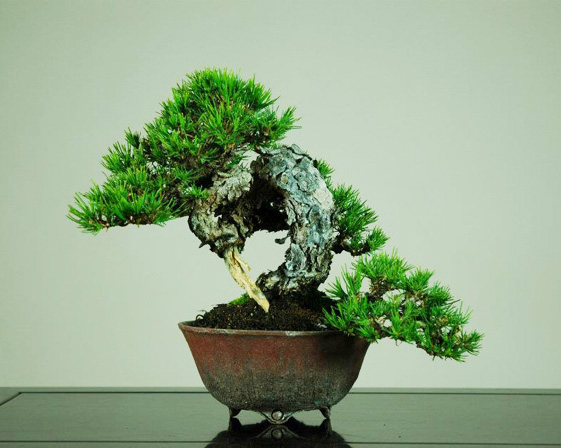 More Mario. We just featured a bonsai of Mario Komsta the other day and now here’s another of Mario’s trees you might like. If memory serves (occasionally it does), it’s from a sequence on an ever shortening jin. I lost the link but imagine you can find it if you want.
More Mario. We just featured a bonsai of Mario Komsta the other day and now here’s another of Mario’s trees you might like. If memory serves (occasionally it does), it’s from a sequence on an ever shortening jin. I lost the link but imagine you can find it if you want.
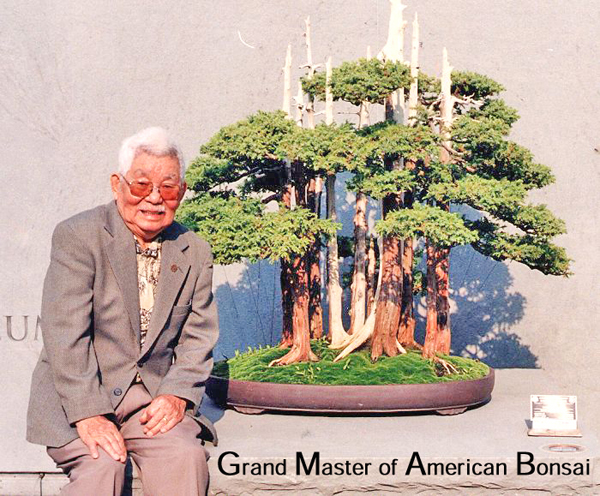 The John Naka Award. The American Bonsai Society in fellowship and remembrance of our American Grand Master is pleased to announce that the 2012 John Y. Naka award program is now open and accepting entries from across the North American continent. For more, visit the ABS website.
The John Naka Award. The American Bonsai Society in fellowship and remembrance of our American Grand Master is pleased to announce that the 2012 John Y. Naka award program is now open and accepting entries from across the North American continent. For more, visit the ABS website.
John Naka Sketchbook. While we’re discussing John Naka, you can purchase the John Naka’s Sketchbook at Stone Lantern (offered in partnership with the National Bonsai Foundation).
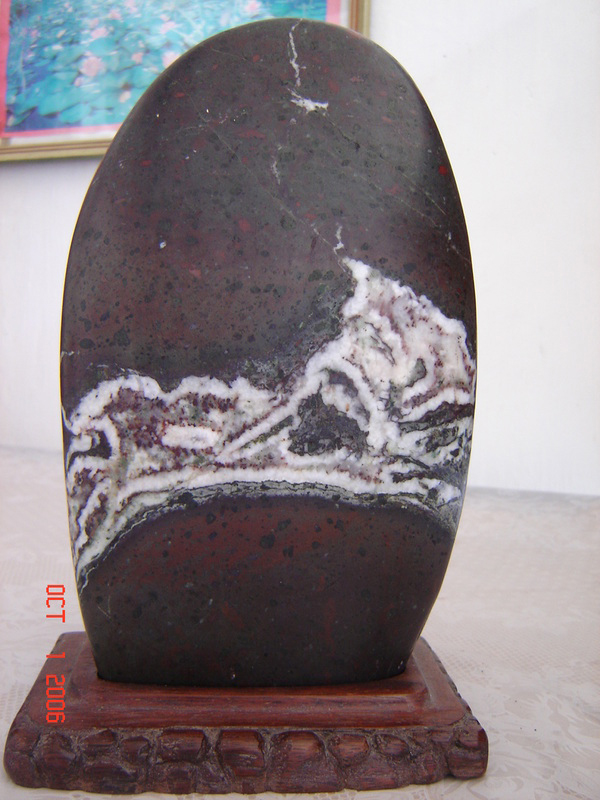 We don’t usually do stones here, but there’s a long bonsai/suiseki tradition, so why not? It belongs to Junius Guiang.
We don’t usually do stones here, but there’s a long bonsai/suiseki tradition, so why not? It belongs to Junius Guiang.
Bad new about lime sulpur by Colin Lewis
To get straight to the point: Lime sulfur is now totally banned in 46 states. Of the remaining four states, two only permit the use of lime sulfur under special license and the other two are currently processing a total ban. According the State of Maine the primary consideration is the potential effect of residual lime sulfur on ground water, not because of the risk to users. (Oregon State University, the major researcher into such things, describes it as having “low mammalian toxicity”.)
Until recently, the penalties for ignoring the bans in the prohibiting states were imposed on the user. However, now the penalties – and not insignificant penalties – are imposed on suppliers who ship lime sulfur (calcium polysulfide) to prohibiting states. Some nurseries will still have residual stocks, but that will not last long. Some importers will continue to acquire lime sulfur from Japan, but as soon as the first one falls foul of the law the others will cease.
The upshot is that lime sulfur will soon no longer be legally available to bonsai growers.
Before you jump to conclusions: No, this is not a cynical attempt to sell you my own brand of lime sulfur before the year end. The truth is that I only have a third of a bottle left for my own use and I can’t get any more!
Although I’m not normally prone to self-mutilation, I am, as I write, viciously biting my lip in order to avoid a rant which could easily become far too heated for this newsletter! But then, I imagine most of you feel much the same….
Now I’ze a bit konfoozed. I recently heard of this impending ban; then read that various bonsai growers, here and there across the country, had gone to buy lime-sulfur and had no trouble at all doing so! I’m certainly not calling Colin Lewis a liar, but does anyone know for sure what the situation is?
‘Course, maybe I should just bop over to Lowe’s and see if I can buy the stuff …
Hi Steve,
It would be great if you (or others) found a way around the ban.
Let us know.
I simply don’t get it. Sulfur is a common soil additive in the nursery trade and isn’t banned. Lime is a common soil additive in the nursery and gardening trade and it isn’t banned.
Both occur naturally in many locations all over the world. You want some, get a old pot, some lime and some sulfur, put water in the pot and add half and half lime and sulfur. Boil it. Pour into a bottle when it cools down. Don’t buy into the story about how bad it stinks. Sure it smells a little but do it outside on a day there is a breeze and don’t breath the steam coming off the pot.
The miniscule amounts used as Lime Sulfur even in commercial application is nothing.
I’m not buying into that it is banned. I’m holding out until I see a regulation, Federal or state that says it is banned.
As far as proportions, wing it. You want to make a gallon for you and your friends use a gallon of water, make a quart for yourself, use a quart of water. Measure out some lime and sulfur, say for a quart of water a half cup of each, dump in the water when it starts getting hot. Get a stick and stir it continually as it comes to a boil. You don’t want clumps of either ingredient to form and or to stick to the bottom of the pot.
Boil it for a while and keep stirring frequently. When you have boiled off some of the water and the mixture is slightly thicker than when you started turn off the heat and let it cool.
Bottle it and before you use it, shake it up. Don’t breath the fumes off the cooking process, there will be a small amount of sulfur dioxide in the steam and it can be an issue if you get too much of it. Do this outside and on a day where there is a breeze blowing or set up a fan to blow across the work area to keep the fumes from stagnating around where you are working.
Yep, your neighbors might wonder if you have a septic tank problem or that you have opened a sewer treatment plant in the yard. That’s the smell you’ll produce. It won’t hurt anyone as long as you are not directly in the steam coming off the pot.
The process might not be elegant but it is effective.
In addtion. The sulfur tends to lump. One way to combat that is to put the sulfur you are going to use in a can, add a small amount of the hot water to the can a little at a time, like a tablespoon full at a time. Mix the sulfur until you have it all wet and the lumps are broken up. Then dump that mixture into the pot with the lime.
OK, I got the note from Colin, I would love to see in writing (from the agencies that can ban the substance) that bans are in place. The EPA required the registration of lime sulphur as a fungicide in. 2005 as it had been made available for sale prior to the 1984 registration requirement. There are states (46?) where the use has not been registered, however, my understanding is that there are only 5 states where lime sulphur cannot be shipped. So let’s see the documentation that it is actually banned.
We have reviewed both the Pine book and the Juniper book; however there is a 6 month delay in posting things on our website. These reviews were in Newsletters more recent than that. I recommend the Pine book to all.
If you read the EPA website the last study on Calcium Polysulfide (lime sulfur) they approved it for use and reregistration. The link is below you can read section I. Executive Summary
http://www.epa.gov/oppsrrd1/reregistration/REDs/inorganic_polysulfides_red.pdf
In fact I just got a huge bottle yesterday:
http://www.fertilome.com/product.aspx?pid=84d72980-10d2-4a06-a891-738b0f54455e
i just went to the EPA website and the only reference there specifically to Lime Sulphur was a 2005 paper saying 1) its toxicity was relatively low to mammals, especially if proper protection is worn to cover eyes, skin and breathing, and that 2) it was eligible for re-registration as a usable substance. i could find no reference to a ban. Fred Elford
I have contacted the North Carolina Dept. of Agriculture and asked if there is any restrictions on it’s use in NC. If or when I get an answer I’ll post it here.
Calcium Polysulfide would lead one to think that the mix to make should have more sulfur than lime, so if you make it try 1 part lime and two parts sulfur. See how it comes out.
The big expense is buying a bag of the two ingredients, once you have that fiddle around with the formula and see what works best. The stuff I made was equal parts of both and seemed to work fine and just like the stuff sold commercially.
Ho Ho! I just went to Wikipedia and ran lime sulfur on there. It tells you exactly how to make it.
I read the post this morning and ran out and bought 9 pints and had no problem. Not sure what’s going on with this ban but quite a few nurseries around here still have plenty. Hope someone figures out what we do when this stock runs out!
Thanks Ken,
I appreciate your reviews and look forward to seeing them on the Columbus site.
Of interest:
The EPA re-approved Lime Sulphur’s use in 2005, saying it posed no real risk to fish, people or the food supply:
http://www.epa.gov/oppsrrd1/REDs/ino…lfides_red.pdf
The Univesity of Washington includes it in preventatives for stone fruit crops for 2011:
http://cru.cahe.wsu.edu/cepublicatio…419/eb0419.pdf
Or just buy sulfurated lime concentrate from a pet shop. Same product, a lot cheaper.
Deep breath….Relax
Okay – here’s the deal as it stands: The environmental concern is contamination of surface and ground water in areas where lime sulfur is used on a commercial scale (orchards, vineyards, etc). For some uncanny reason the EPA or whoever decided that the product should be registered in each state where it is used. Naturally everyone ignored this and merrily sold the stuff to the agricultural and gardening markets. The ban (perhaps I used too strong a word) is a de facto prohibition resulting from recent more stringent enforcement, and the introduction of a higher fee, of the pre-existing annual registration requirements – and more severe penalties for those manufacturers who do not comply.
Since the use of lime sulfur in most states is negligible, manufacturers simply don’t want the bother and expense of re-registering in fifty states. Lime sulfur that is still in stock can, of course, be sold through, which explains why it’s still easy to find in some places.
However…. I have this very day been discussing with a manufacturer mutually beneficial ways to comply with the legal requirements yet still be able to sell JinSeal outside of the state of Maine. If all goes well I should be able to resume at least wholesale supplies within a few weeks.
An online recipe for lime sulphur – note the proportions of sulphur to lime
Disclaimer: I haven’t tried this and the thought of 20 liters of of concentrated lime sulphur does make me feel fearful!
Carl
From http://milkwood.net/2010/11/02/biofertilizer-recipe-2-lime-sulphur-caldo-sulfocalcico/
Here is how you make Lime Sulphur, a fungi-preventative foliar preparation:
Materials:
1. Steel bucket capable of holding at least 30 litres, with a lid and, preferably, some handles. (we cut down a 44-gallon drum and welded some handles on. The lid is just to keep dust and rain out while it cools -it doesn’t need to be sealed)
2. 2m long stake for stirring the preparation
3. Bricks to raise the bucket above the fire
4. A good pile of wood, enough to keep 20 litres of water boiling for at least 1 hour
5. A funnel and fine mesh (pantyhose is great) to decant the preparation once it’s made
6. A bunch of plastic or glass bottles to decant the preparation into.
Ingredients:
1. 20 litres water
2. 5kg sulphur powder
3. 1/2 kg lime
4. 1/2 kg wood ashes
Directions:
Position bucket on bricks with enough room underneath for a decent campfire, and add 20 litres of water to bucket.
Bring water to the boil (putting a lid on speeds this step up)
Weigh out your sulphur powder, lime and wood ash, and mix them all up in a separate bucket.
Once the water is boiling, carefully and slowly add your mix of ingredients.
Stir your bubbling bucket of goodness with your long wooden stake until everything is well dissolved. Stir a bit more for good luck.
Keep the mix boiling for a minimum of one hour
At this point, the colour of your brew should be a rich, dark red colour, with pale yellow scum. If it doesn’t look like this, keep boiling until it does.
The preparation is ready when the liquid is a clear, deep amber, with a pale yellow sediment. Take a transparent scoop (1/3 of a plastic bottle is a good one) and carefully scoop some out of the bucket. If you see clear amber with pale yellow sediment, you’re done!
Allow bucket and liquid to cool completely, and for the sediment to settle on the bottom. Again, having a lid helps here. We left it overnight.
Now you are ready to decant your lime sulphur mix.
Your lime sulphur mix is now made! The sediment at the bottom can be used for painting on fresh cuts on woody plants (after you’ve pruned your trees, for example) as it prevents fungal infections entering the tree at this point.
To all of you guy’s who are thinking of putting in a stock of Lime Sulphur remember that the more the Lime Sulphur in the bottle is exposed to air the more it degrades and become weaker and unusable.
One way to counter this is every time you decant an amount from the bottle put back into the bottle an inert product such as gravel so that no air is in the bottle.
Thanks Colin and thanks to all of you who have pitched in and joined the discussion.
Lime sulfur isnt banned in the U.S.! I spoke personally with many manufactures and they have not been notified of any cease to manufacturing calcium polysulfide. Also i spoke with the united states national division of the enviornmental protection agency and there is no nation wide ban on lime sulfur. I dont know where this information came from but it is just not true. People are freaking over nothing. I just bought a case of one quart bottles of hi yeild brand lime sulfur and they thought i was nutts! I told them why and thay said theyve not even heard of such a thing and until they do their going to keep making it everyday. There is a specific set of regulations that must be followed in certain states but as far as a ban, no there isnt one. Donald Bumgardener from the national division of EPA is sending me an article on this subject today or tomorrow and i will post it as soon as i get it. I just talked to him on the phone 5 minutes ago and i asked him to e-mail this information so i can have postable proof for people to see. I will also post it on all the bonsai forums i am a part of and i plan on making a video for my youtube channel wich ill post the address to when i post the letter. Thank you everyone and dont freak out, theres no ban. I know because i went to the person that would put in place such a regulation should there have been one. Jake
Jake,
If you had read my last post you could have saved yourself the trouble. Lime sulfur must now be registered by each manufacturer individually in every state, not just one national blanket registration, and the fees are not cheap. It simply is not cost effective for manufacturers to do this. You may have a manufacturer in your state who has registered in your state, but I doubt they have registered in all fifty. If they haven’t, and they ship out of state, they’re breaking the law.
However, I have now reached an arrangement with the largest manufacturer that enables me to legally purchase stock and resume wholesale supplies of JinSeal.
I totally agree – I’ve visited the Phoenix Bonsai Site on many occasions and always found valuable information. Congrats to the Phoenix Bonsai Society for
50 years.
Lime Sulfur is not banned, and Colin is 100% wrong. Lime sulfur is used in soil remediation of heavy metals and widely used in agriculture. It is massed produced by one of the largest chemical companies in the world. If it was banned the EPA would be all over them. Lime sulfur degrades to calcium hydroxide and sulfur, it is approved for use under California prop 65, and is safe for ground water. The EPA approved the use in 2005. It also can clean fly ash, make concrete and many other applications. Stop spreading bad information. It can be shipped, mailed, etc… The smell is strong, but harmless. Just don’t mix it with acid, and stop spreading fear Colin you have no idea what you are talking about. If you want information contact Tessenderlo Kerley, Inc. ask about Calmet solution.
Hi James,
Yes, we know. We addressed the issue in a post not too longer after this one: https://bonsaibark.com/2012/01/26/lime-sulfur-a-story-with-a-happy-ending/
Ok what about lime sulphur dip used for animal care ? Can that be used the same way for whitening the wood or Jin ?
Phil,
I just went back an amended the paragraph on lime sulfur. Turns out, it’s okay. Much ado about almost nothing.
Lets get to the real reason, shall we.
The reason lime sulfur is banned is because people are using it
in record numbers to commit suicide in the USA.
If you mix lime sulfur with Lysol liquids (toilet bowl cleaners,
disinfectants, etc.) you get deadly hydrogen sulfide gas (HS2).
Five times more toxic than carbon monoxide this stuff can knock
you out cold in a few breaths in an enclosed area (car, shed, etc).
A few breaths more and yer finished…its that quick!
This quirky fad started in Japan and has spread quickly to the US.
As a result they have banned lime sulfur almost everywhere.
Now you know the real story behind the nursery newsletters.
I suppose we need to ban Di-Hydrogen Oxide also. It kills all kinds of people every year.